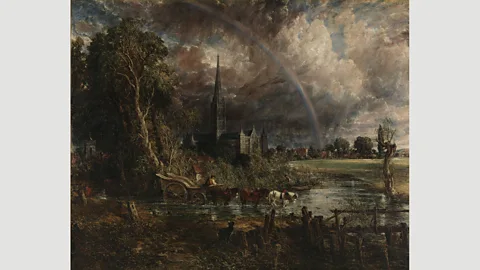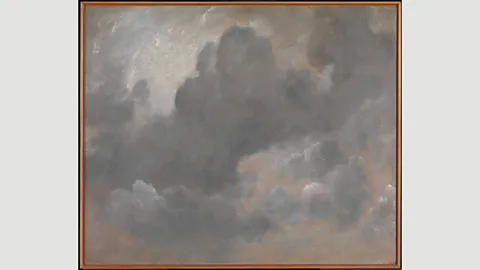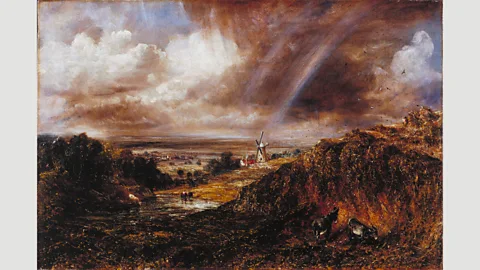Why this striking rainbow may carry a hidden message
 Tate
TateThe skies of Constable’s paintings aren’t just beautiful. There is science in them too – which is how a meteorologist unlocked a message in one of the artist’s most famous works.
A mystery surrounding one of John Constable's most emotionally-charged landscapes may finally have been solved – by a meteorologist.
Constable, one of Britain's most celebrated landscape painters, considered the vast, 2m-wide Salisbury Cathedral from the Meadows – currently on display at the Salisbury Museum, after which it travels to the National Galleries of Scotland – his greatest work. He first exhibited it in 1831 while grieving the loss of Maria Bicknell, his beloved wife and mother of his seven children. The couple had spent part of their honeymoon in Salisbury, and the town was also the home of Constable's best friend, the Archdeacon John Fisher.
Art historians have long interpreted the painting's turbulent sky as a reflection of Constable's intense and tumultuous mourning, its brooding storm clouds pierced by a perfect rainbow symbolising hope and happy memories.
But there is one problem with this interpretation: recent research has shown that, in all probability, Constable's original painting did not include a rainbow. He added it later.
Why did he change his masterpiece? Professor John Thornes, professor of applied meteorology at the University of Birmingham, believes he has found an answer by dating the rainbow using modern computer software. His theory is that Constable painted it in to commemorate his friendship with Fisher, who died about a year after the work was first displayed.
“Constable had a real knowledge of meteorology – probably as good as any contemporary meteorologist at that time,” Thornes says. “He studied rainbow science and had some quite mathematical friends who we think taught him about rainbows.”
Rainbow connection
Given Constable's expertise, Thornes was surprised to find that the rainbow could not have appeared while Constable first painted Salisbury Cathedral. Rainbows can be dated very precisely based on their position in relation to the sun, and Thornes' analysis revealed that this one would have graced the sky on 25 August 1832 – the date of Fisher's death. The end of the rainbow touches Fisher's house.
 Tate
Tate“It's pretty obvious that Constable put the rainbow in as a commemoration of the life of his best friend,” Thornes says. “This explains why the rainbow doesn't fit into the painting – it's a commemorative symbol.”
There is other evidence that the rainbow was added later. The curator Amy Concannon at the Tate, which acquired the painting for £23.1 million in 2013, inspected the canvas after the purchase. She noticed that the rainbow was sitting on top of the other layers of paint and had not been part of the original composition.
Concannon also researched the reaction of critics to the work when it was first displayed at the Royal Academy in 1831. While they commented in detail on the sky and clouds, none of them mentioned a rainbow. However, when Salisbury Cathedral was exhibited again in Birmingham in 1834, critics reacted to the rainbow, suggesting that the painting had been modified.
“I think his theory is very plausible,” says Concannon. “Constable was one of those artists who never thought anything was quite good enough; he was plagued by self-doubt. So even though the painting had been exhibited, he took it back to his studio and continued working on it.”
Constable himself was apparently pleased with the changes. “I am sure I have much increased its power and effect... I have no doubt of this picture being my best now,” he wrote to a friend before the Birmingham exhibition.
 Tate
TateDoes the rainbow's newly revealed significance mean the painting is really about friendship and loyalty, rather than love and grief? Concannon at the Tate says that it may be both. In fact, she thinks the painting is a reflection of several emotional and political upheavals that were affecting the artist. They show the more complex side of a painter often associated with images of rural idyll.
Many of Constable's works feature bucolic scenes of meadows and horse-drawn carts, such as The Hay Wain, which has been voted Britain's second-favourite painting. But this chocolate-box reputation belies the turmoil that drove Constable to paint Salisbury Cathedral.
Constable had been devoted to his wife, moving his large family to the seaside and to Hampstead in the hope that fresh air would improve her ailing health. After she died from tuberculosis in 1828, he deeply mourned the loss of his “departed Angel”, as he called her in a letter to his brother. Archdeacon Fisher sheltered him in his house during this period of grief, and the archdeacon’s own death in 1832 would have been another emotional blow.
Threats on the horizon
At the same time, political and religious change threatened Constable's conservative outlook. Reform activists were questioning the Church's central role in British life and its closeness to parliament – the Church of England was, and remains, the state church and its bishops sit in the House of Lords. Reformers wanted to curb its power and separate church and state; Fisher and Constable opposed the reformers. They discussed how to capture the conflict artistically, with Fisher eventually writing to Constable that a church under a cloud would be the best option.
“So the reformers were the clouds that threatened the Church,” Concannon says. “It seems very clear to me that it's a painting about politics.”
 Tate
TateAfter Fisher died, Constable possibly added the rainbow not only to honour his friend's memory, but also to express a slightly more optimistic view of the political situation, according to Concannon.
“It's an act of acknowledgement of his friendship, but also a sign of hope that the future – for himself personally, and perhaps for the Church – wouldn't always be as rocky and tumultuous as the previous years had been. Maybe the passing of his friend put things into perspective for him,” Concannon says.
Whatever the precise symbolism of the painting, Constable went to great lengths to depict the rainbow so accurately that it could be dated. According to Thornes, Constable did not paint the rainbow on the day of his friend's death, but rather recreated it later using his knowledge of solar geometry, meaning the position of the rainbow in relation to the sun. This made it possible for Thornes to determine when it would have appeared. The meteorologist used recently developed software that is able to calculate the solar geometry of any rainbow at Salisbury for any day of the year.
“The rainbow is a bit like a clock,” Thornes says. “When you see a rainbow in the sky, you can date it if you've got something to compare it with” – much like a sun dial. “In this case, we've got the cathedral, so we know exactly where the sun would have to be for a rainbow like that to occur.”
 Tate
TateConstable had a passion for understanding the science of the skies that inspired his art. Between 1820 and 1822, when he was living at Hampstead, he painted more than 100 studies of the sky, including detailed oil sketches of clouds accompanied by notes on the time of day and direction of the wind. He also wrote about the geometry of rainbows and analysed their shapes and colours in diagrams. Thornes says this sets Constable apart from other landscape artists such as Claude Monet and JMW Turner, who painted more intuitively.
“Constable said we see nothing truly until we understand it,” he said. “And the rainbow is a case in point. You don't see a rainbow properly until you understand how it's formed.”
While Thornes may have solved the mystery of when and why Constable added the rainbow, other questions remain open. Thornes' next ambition is to find out exactly how Constable recreated the correctly dated rainbow for his painting, possibly using a piece of string or scientific instruments. Meanwhile, Concannon is hoping to uncover more about the political content of the painting and the public's reaction to it.
“It's quite complicated, really, but that's why it's such a powerful painting – there's more to it than meets the eye,” Concannon says. “There always is with Constable, but that picture says that more than any other.”
This story is a part of BBC Britain – a series focused on exploring this extraordinary island, one story at a time. Readers outside of the UK can see every BBC Britain story by heading to the Britain homepage; you also can see our latest stories by following us on Facebook and Twitter.
And if you liked this story, sign up for the weekly bbc.com features newsletter, called “If You Only Read 6 Things This Week”. A handpicked selection of stories from BBC Future, Earth, Culture, Capital, Travel and Autos, delivered to your inbox every Friday.
